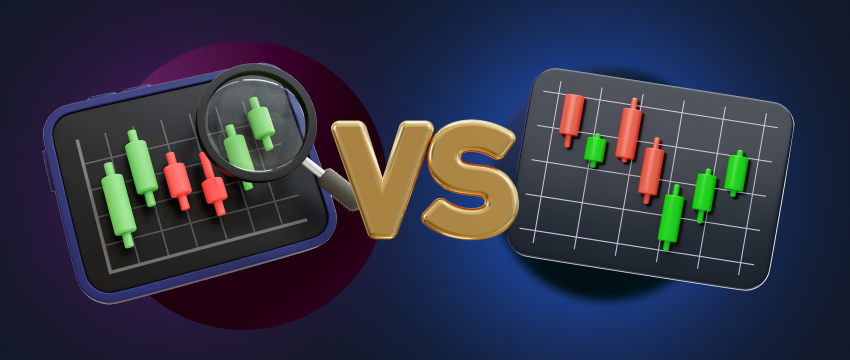There are four main types of forex trading: scalping, (short-term investing) day trading, swing, e position trading. In this article, we’ll look at the different types of forex traders, the strategies they use, and a lot more.
Day trader
Day trading involves buying and selling forex currencies within the same trading day, without holding positions overnight. Short-term traders buy and sell currency pairs to capitalise on intraday price fluctuations.
They avoid the risk of slippage and overnight funding costs. Before they open their first position, they must consider market volatility, liquidity, and trading volume. A trading plan and effective risk management are essential.
A day trader must be patient and focus on analysing price charts and economic data efficiently and accurately. Since day trading is over a short time frame, making quick decisions is crucial.
This trading style suits forex traders who can dedicate enough time each day to analyze, execute, and monitor trades.

Scalpers
Scalping is a popular trading strategy where traders aim to profit from minor price changes.
Traders who use the scalping strategy place from 10 to a few hundred transactions in a single day, small movements are easier to catch than large ones.
The main aim for forex scalpers is to gain very small amounts of pips as many times as they can during the busiest times of the day.
Traders usually hold these types of trades for a few seconds to a few minutes, and in some cases, up to several hours.
All positions are closed at the end of the trading day. Scalpers depend on devida análise to identify entry and exit points.
Scalpers must stay disciplined and stick closely to their trading plan. They should make every decision with confidence.
However, scalpers should also be very adaptable because market conditions are always changing. Therefore, if a trade isn’t going as well as expected, they must quickly fix the situation without suffering a big loss.
Swing trader
Swing trading refers to the medium-term trading style that forex traders use to profit from price swings.
Momentum traders identify a possible trend and then hold the position for several days to a few weeks.
Unlike day traders who execute multiple transactions within a single day, swing traders enter positions expecting the market to move in their favour. Timing is more important for swing traders compared to day traders.
Swing traders often rely on a combination of technical e o a análise fundamental to identify optimal entry and exit points.
Swing trading is an ideal trading style for traders who cannot monitor the charts during the day, but can usually dedicate a few hours analysing the market every night.
Position trader
Position traders look at a longer-term plan instead of monitoring short-term market movements like day trading and swing trading. They tend to hold positions for weeks, months, or even years.
This type of trading is similar to “investing”. The key difference is that in markets outside forex, investing usually involves holding long-term positions.
Traders mainly rely on fundamental analysis to identify undervalued or overvalued assets, and use technical analysis as a secondary tool.

Other Factors to Consider for the Forex Traders
For all types of traders, there are also other factors that influence trading outcomes.
Time frame isn’t the only factor. Every trader needs to know about other important aspects that impact traders on an individual level. Let’s have a look at some of these:
Utilize as ferramentas
Leverage can be a day trader’s best friend when used correctly. But it is also like a double-edged sword. Basically, if traders lack the proper tools they cannot capitalise on potential opportunities.
So, day traders must always think about how much leverage or risk they are willing to take on before executing any trade.
In the same way, swing traders should also consider their risk tolerance. While swing traders often aim for longer-term fluctuations, they may experience some losses before making any gains.
Different currency pairs for forex traders
As well as leverage, the volatility of currency pairs is also an important factor. It’s important to know not just how much you can lose per trade, but how quickly losses can happen. Different time frames suit different currency pairs.
For example, the British pound/Japanese yen currency cross can move 100 pips in an hour.
This is challenging for day traders, but it may not work for swing traders aiming for longer term trends.
For this reason, swing traders often follow more widely recognised G7 major pairs which are more liquid than emerging market and cross currencies. For instance, the euro/US dollar is a better choice than the Australian dollar/Japanese yen.
News
Traders need to always be aware of the impact that unscheduled and scheduled news releases have on the market.
All types of traders will have to make individual adjustments, whether these releases are economic announcements, central bank press conferences, or the odd surprise rate decision.
Short-term traders are usually affected the most, as losses may be worse. In contrast, position traders are less impacted due to a longer-term outlook. They anticipate temporary price disruptions and stay focused on their long-term targets.
A good example occurs on the first Friday of every month with the US non-farm payrolls report. Short-term traders face volatility after each release, while longer-term position traders remain unaffected due to their longer-term bias.

Which Time Frame is Best for Forex Traders?
The right time frame depends on the trader. It depends on how well they handle volatile currency pairs, or whether they have other commitments and prefer the stability of long-term trades. They don’t need to stick to just one approach.
How do forex traders become successful?
Forex traders speculate on the relative values of major global currencies in relation to one another. As well as speculating on spot rates, they can also capitalise on the relative interest rates of different currencies.
For instance, to profit from a rate differential, traders may sell a currency with a low interest rate and buy one with a higher interest rate.
Conclusão
Identifying a trading style is a key step in developing a strategy tailored to individual preferences and needs.
Regardless of the chosen style, it should align with specific requirements. By understanding and adapting a preferred approach, a structured trading plan can be built, improving consistency in the forex market.
Frequent changes in trading style may create challenges and lead to increased losses. For example, if scalping proves too fast-paced or exhausting, transitioning to a different trading method may be a practical solution.
There is no single approach to trading, and the key to long-term success lies in self-awareness, continuous learning, and adaptation.
INFORMAÇÃO LEGAL IMPORTANTE: Esta informação não deverá ser considerada como aconselhamento ou recomendação ao investimento, mas apenas como comunicação de marketing.




